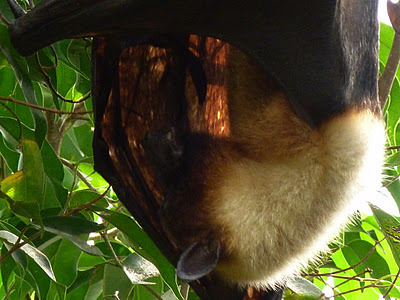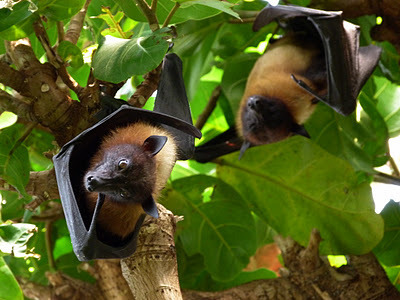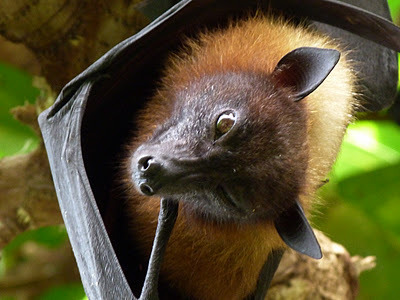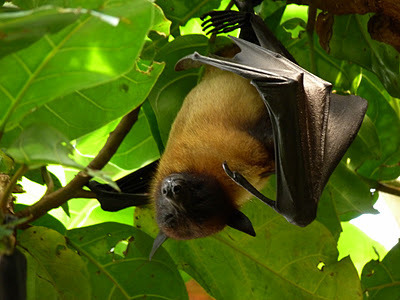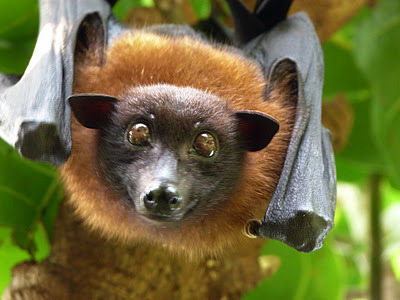Gordon Grice's Blog, page 76
October 30, 2011
Rothschild's Atlas Silkmoth and Luna Moth
[image error]
The Rothschild's Atlas Silkmoth of Central and South America.

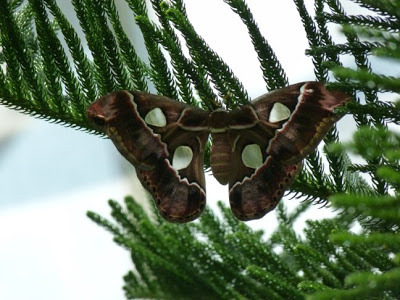

The Luna moth of North America. Dee tells me both of these live a week or less in the adult form.

Photography by Dee Puett
The Rothschild's Atlas Silkmoth of Central and South America.



The Luna moth of North America. Dee tells me both of these live a week or less in the adult form.

Photography by Dee Puett
Published on October 30, 2011 08:38
October 29, 2011
Heatwave Brings Death's-Head Moth to Britain
[image error]
Moths are the ghosts of the insect world. It may be the manner in which they flutter in unheralded out of the night that terrifies us. They seem to tap against our lighted windows as though the outer darkness had a message for us. And their persistence helps to terrify. But they are most terrifying of all if one suddenly sees their eyes blazing crimson as they catch the light. --Robert Lynd
As if to prove global warming isn't all bad, the United Kingdom is getting a glimpse of gorgeous--and sometimes scary--insects rarely seen there:
Heatwave attracts flight of colourful tourists from Continent - Nature, Environment - The Independent:
"The death's-head hawkmoth, Europe's most infamous insect, which bears the likeness of a skull upon its back, has turned up in England as part of the biggest influx of continental moths for many years. Several specimens have been spotted along the south coast.
Last weekend's extraordinary hot, caused by a mass of warm air surging up from southern Europe, brought with it hundreds of moths of numerous rare species from France, Spain and even the Mediterranean."
Thanks to D'Arcy for the news tip.
Published on October 29, 2011 08:57
October 28, 2011
Flying Foxes
Published on October 28, 2011 09:00
October 27, 2011
Rattlesnakes Denning

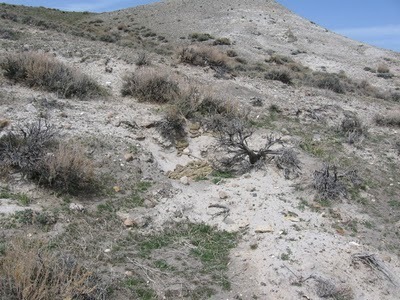
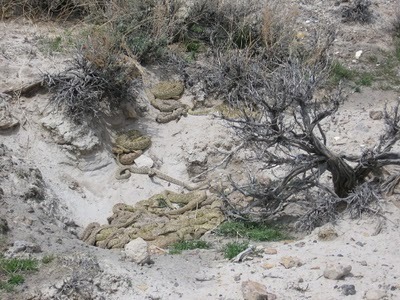


Thanks to Amanda, who forwarded me this set of photos featuring the denning behavior of rattlesnakes. Forwards are of course not always to be trusted, but this one claims the dens are in the area of Fort Smith, Arkansas. Rattlesnakes congregate for the winter, sometimes by the thousands. These look to me like prairie rattlers, the kind I mostly grew up with in Oklahoma. For more about rattlesnake denning, see The Red Hourglass.
Published on October 27, 2011 09:00
October 26, 2011
Bat Country, Conclusion
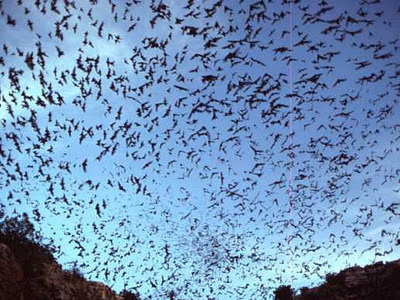
The buttes rimming the valley jut like human molars. They're made of sandstone compacted in layers. Ages of water eroded the land around these relatively durable patches of sandstone, sculpting the rest of the landscape away to leave the buttes.
Some of the less durable parts of the land are made of gypsum. Gypsum erodes into angular particles of sand that sting when the wind drives them. But, in an accumulation on the ground, gypsum sand takes on a peculiar fluidity, rippling along into drifts and dunes. It is softer to the touch than quartz sand.
Water eats greedily at gypsum, dismantling it faster than many other minerals. Because the buttes are riddled with gypsum, they are also riddled with caves. Rena explained this business as she made us stop and look west. The butte there was just going dark as the sunlight leant toward the horizontal. "What do you see?" she demanded.
"A butte," someone said.
"A window," someone else added.
"A window," Rena confirmed. It looked a perfect rectangle punched high in the face of the butte. "Just like everything else in this valley, it's a product of water erosion." The desiccating wind slapped her hair around into her face, as if mocking the idea of moisture.
The professionals, as it develops, discovered this hole only the night before. Davis had climbed the butte this very day to explore the discovery. He found a chimney in the top of the butte which seemed to connect with the horizontal shaft starting at the window. "I could see about a dozen feet down," he said. "I wasn't going in."
Everybody laughed. Everybody knew what he hadn't bothered to say: Western diamondbacks live in holes like that. These reptiles grow thick as a man's leg, and they kill more human beings than any other snake in North America. After a pause, the stories about people bitten by diamondbacks started up. The peculiar thing about diamondbacks is that tall tales you hear from fools and liars are never as horrible as truths you hear from biologists and doctors. This day the best horror story detailed a bitten leg that swelled until it "busted just like a ripe tomato."
The diamondbacks in this region grow to more than seven feet long and thirty pounds. These measurements are meager compared to some tropical or marine reptiles, but they're substantial for a cold-blooded animal in a country of dry, boiling summers and ground-freezing winters. The secret of their survival here is the very wrinkling of the earth. In the eroded furrows that line the buttes, they can sulk through the sunny days. In the gypsum caves, they can lie in a mass with hundreds of their brethren beneath the frost line, sluggish through the winter. Occasionally a hunter sees a few of the reptiles basking on rocks on a clear winter day--then he knows he's near a den of them.
The diamondback survives by plugging itself like a sizzling power cord back into the earth. After traveling for miles in the summer, the snake finds its way back to the same den each winter. The young home in on an ancestral den they have never seen. The senses that guide this miraculous slithering journey are unknown. Rattlesnakes are known to have a heat-detecting sense and an extraordinarily acute chemical sense. Some think they can also navigate by the sun.
A researcher I knew spent a great deal of money for radio signaling devices. He captured rattlesnakes and operated on them to implant the devices. Then he tracked the snakes for a year, through their warm-weather wandering and hunting and mating and their autumn return. On the maps where he plotted his data, the migrations of the snakes might have diagrammed solid particles sucked into the swirling mouth of a drain.
I asked the researcher what could explain such a feat of navigation.
"Nothing," he said.
*
The bats are an ancient order of mammals, diversified into 900 species. Human beings have never quite known what to make of them. They've been classed as cousins of the monkeys and brothers of the rodent, though modern science claims they're no relation to either. Old myths explained them as symbols of luck or denizens of Hell. When Cortés came to America and found a kind of bat that drank blood, his reports only echoed the European legends of winged succubi and soul-takers.
The strangest aspect of bats--their mastery of echolocation--is now common knowledge, but it was greeted as a fool's fantasy when a scientist first described it in 1938. The bat lives in a world painted in shades of its own voice. The various species speak in different ranges, so that a scientist with an ultrasound detector can tune his machine to read the species he's interested in. Individual bats have distinctive voices. In a maternity colony, the mothers return from their nightly hunts to find their young, and each mother detects her own pup among the multitudes by the sound of his voice. Some bats seem to read textures with sonar as well as a human can by touch. They can distinguish between a thrown pebble and a hard-shelled beetle. A bat knows whether insects are approaching or receding. He instinctively grasps the Doppler effect their movement has on the frequency of his returning voice. He reads them as a meteorologist reads the track of a thunderstorm.
Some of a bat's sensory feats are beyond our grasp. No one knows, for example, how a bat finds its way on long journeys. A bat taken many kilometers from home can find its way back, as dogs are said to do. Some scientists think the bat navigates by the stars. Others think it is tuned to the magnetism of the earth.
*
At dusk I sat with the professionals and the volunteers on wooden benches facing west. Our scattered party had gathered with the gloom. Another kind of party was about to disperse.
"The State's official estimate is one million bats in this colony," said Davis. "Personally, I think it's more." He was whispering to me, because he didn't want to interrupt the discussion the other professionals were leading. They were bringing the volunteers to the climax of their indoctrination, formulating the larger meaning of the natural text they had explicated all day. Their message was one of conservation, under which, no longer disguised in the facts of biology, lay a sort of religious belief. Rena spoke of individual molecules cycling unchanged through stone, grass, herbivore, predator, larger predator, until they finally wash to the sea. Another biologist spoke of food chains and an "energy flow" that binds every living thing.
One of the volunteers read out an essay on "energy flow" which the professionals had recommended to him. As he read in the failing light, attempting a certain dramatic flare, someone whispered urgently, "They're out!"
Suddenly everyone was pointing and whispering, trying to locate the single bat the colony had sent out as a scout. The volunteer read on, unwilling, I suppose, to interrupt his sacred text. Despite the gloom, the buttes still looked red as sunburn. But the vegetation was graying toward darkness. The opening of the colony cave is somewhere in one of the buttes, though the professionals wouldn't say exactly where. Rena had admitted to me earlier that the nature walk isn't merely educational. It's also meant to disorient the tourists so they can't return to find the bat cave on their own and despoil it.
Everything was silent except for the voice of the reading volunteer and the quiet call of a wood duck. A power line ran behind the buttes, and on it sat a dark silhouette. "There he is, same as usual," someone whispered. It was a great horned owl. I'd seen them before, watching the night with eyes like fractured amber, eyes that seem to return your gaze. When they take off they often leave a stinking pile in which you can find undigested bones, if you have the stomach for such an inquiry. This one knew the schedule of the bats. It came to take one of the million every night.
We kept straining our eyes for the scout. Two nighthawks crossed the quiet air in front of the buttes, the white bands on their dark wings flashing each time they turned. They, too, had come to prey.
Bats when they fly have of necessity their wings coveredcompletely with a membrane, because the creatures of the night on which theyfeed seek to escape by means of confused revolutions and this confusion isenhanced by their various twists and turns. And to the bats it is necessary sometimesthat they follow their prey upside down, sometimes in a slanting position, andso in various different ways.
--Leonardo da Vinci
Suddenly a few bits of something were floating in the air between two buttes. They might have been shrapnel from a slow explosion. They rose. Everyone was whispering excitedly, and the eager volunteer finally finished his reading and watched with the rest of us. The bits of shrapnel became more numerous, forming a column which broadened at the top to resemble a silent tornado. The tornado moved toward us. Suddenly the twilight sky over our heads was pocked with uncountable puncture wounds, moving without a noise to the east. The silence was relative. To some of the insects and birds out that night, the conglomerate of sound must have been louder than nearby thunder. It was simply too high-pitched for human ears.
Occasionally one bat flew a little lower than the rest, and I could see the shape of the thing, its rapid wings appearing as short, sharp triangles cowled in the ghost of their own motion. Each of the professionals raised a hand and rubbed the fingers together as if contemplating a snap. They were making a little bug-noise to draw the bats down into better view.
A few moments before, I had been only subliminally aware of the insect life around me--moths popping out the undergrowth, gnats venturing too close to my eyes, an occasional mosquito bite. Now I was acutely aware of the absence of insect life. This one colony of mothers is said to scour tons of insects from the sky every night, each bat devouring half her body weight or better to maintain her flying heart-rate of 900 beats per minute.
At a distance you don't see the eating itself. Most people seem to visualize the process as a neat one, the bat gulping insects like a ramjet eats air. In fact, bats eat as messily as anyone else. If necessary, they snag insects with their wings or tails and toss them toward their mouths. They puncture insect husks with their canine teeth and grind down the shells with their molars. You may get lucky enough to see a pair of butterfly wings wafting down, the body devoured from between them.
The birds of prey left, having silently taken their prey in the confusion of the emergence. The wind changed, and the bats turned to the south. They were still streaming out of the cave, and now, seen from a different angle, they looked like particles swept along in an invisible river. And the river wound into deepening dark, streaming beyond the range of human vision.
Published on October 26, 2011 08:15
October 25, 2011
Bat Country, Part 1 of 2
The Book of Deadly Animals hits the UK in ten days. To celebrate, I'm running here an expanded version of a tale I told in the book. In the clip above, James Addison Conrad reads a snatch about bats from the book to get you in the mood. The expanded story begins below.
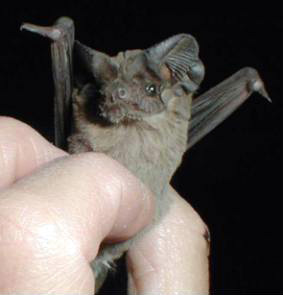
My first one: I was six years old. The thing clung to a cinderblock wall in my father's shop. It seemed feeble, rocking its head to dodge the light, tentative as a shivering newborn kitten. Its was nothing like the image I'd taken from vampire movies on TV. Its blunt face terminated in a nose made of hideous convolutions of flesh. On TV the wings could have been cut from black velvet. The real ones were naked and veined, their gray hide suggesting both the delicacy of a child's skin and the desiccation of an old man's.
I wanted to catch it, but my father told me not to touch it, not even to approach. Months later two older boys at school brought a similar specimen in an aquarium. They brought it to all the classrooms, and we gazed at the creature from some other realm. When it died soon after, the two boys who'd handled it had to be vaccinated. The doctors stabbed long needles into their bellies.
It is a myth, of course, to say they're all rabid. Less than one percent of them are. It's truer to say one too slow and earthbound to stay out of human hands is dangerous--near death, and a possible vector of death.
Instead of This Journey
from Gilgamesh
Eat berries verging on overripe;let their liquor stain your beard. Dance, though your steps be clumsy;let the motion make you new. Sing, though half the words you knowhave sunk into the mud of memory. Bathe in hot water—its steam the ghostsof snakes casting their skins in air,a viperous migration of your caresinto nothing. Dress in clean silk;let the hot wind whip your hair dry. Let the child take your hand—his small hand holding two fingers of yours.At night make love to your wife.In the morning lie luxurious in the scent of it.
Having followed the directions in a press kit, I found myself standing in a landscape of eroded hills and red earth. This rugged country had risen abruptly as I drove the plains of northern Oklahoma. An old couple met me as soon as I peeled myself out of the car. The man had a concavity of eyelid where his left eye had been, and the stump of his left forearm was encased in a leather sheathe and held against his body by one of his suspenders. He said he was a farmer. The woman, who was dressed in yellow polyester and seemed impervious to the heat, asked brightly if I was a volunteer too. I said no, I've only come to watch.
Soon we were piled, with a dozen others, into pickup trucks and driven down a set of dirt roads crusted with caliche. We had vowed not to reveal the route to anyone else. The secrecy was meant to protect the biological treasure we'd come to see. We reached a valley of red cedar and tamarisk, yucca and sand plum, where a hot wind harried the black dragonflies. I gazed into the thin, deep creek that crawled the valley floor and saw a peculiar abundance: minnows swimming in place against the current, sluggish catfish groping in the mud with their tentacled faces. If I hadn't already known about the hidden life of this valley, the richness of fish might have been my first clue. The water trickles through gypsum caves before it gathers into the creek, and in the caves it becomes rich with the leavings of one million nocturnal predators.
High in the mountains, a river's bed is lined with sharp andfaceted stones. Farther down the stones are smaller and smoother. The rivershrinks them. The progress continues, from coarse gravel to finer, from that tocoarse sand and then finer. Where it joins the sea it is turbid with sand andgravel. The sand settles on the shores, cast by the waves. It is nearly as fineas water itself. The sand originated in rotten leaves and other light things.
--Leonardoda Vinci
I'd come here with wildlife professionals and conservation volunteers to witness the emergence of these predators, which would reveal themselves at dusk. Meanwhile it was an arid ninety-five degrees and a fleshy cloud to the south was kneading itself into a tense knot as it approached, as if fretting that it had nothing to give us. We walked the trail, and the professionals stopped us at metal markers to comment. Rena, the lead biologist, struck me as surprisingly pale for someone who worked outdoors. "This appears to be a red cedar tree, but it is really two red cedar trees," she said. You could tell, she pointed out, because one side bore blue juniper berries and the other didn't. If you peered deep into the needled foliage you could see two distinct trunks at the core.
High in the male half of the tree rested a peculiar brown growth. It looked like a furry golf ball with tentacles.
"When it rains, that thing will open up. It'll be like a slimy hand," Rena said.
"It's a parasite that needs two hosts at different stages of its life cycle," added Davis, a biologist with a small face engulfed in an extravagant beard. "It needs an apple tree and a red cedar." Lacking either host, it can't survive. The apple tree, which hosts the ball of rot in its infancy, may be twenty miles distant or more.
We moved on, discussing plant life or the occasional reptile that revealed itself by rustling in its shaded bed of fallen cedar needles. The volunteers were to learn the ecosystem which lay before us, a cryptic web of relations connecting everything from the trees to the insects to the rabbits whose round pellets of scat revealed their existence. The volunteers would have to answer questions from the tourists who would soon scuffle the trails of this park, each busload having first taken the vow of secrecy.
One of those black dragonflies buzzed into someone's face, prompting the woman to windmill ineffectually. Up close, each of the creature's wings seemed branded with blue thumbprints. The biologists reminisced about a monster insect of uncertain order that had terrorized them all for ten seconds at the last dusk. The volunteers offered helpful suggestions about what it might have been, all of which the professionals dismissed. It was, they said, an utter mystery.
A thorny tamarisk stood at an elbow of the path. "Supposedly their roots go a hundred feet deep," said Davis. That's why this imported species can thrive among the dry valleys and buttes of northern Oklahoma. The twisted elms that tossed their heads in the wind were of the Siberian variety, another species imported for its deep-drilling roots.
At a turn of the path, everyone stopped. An unpleasant substance lay in the middle of the trail, its odor announcing its freshness. The professionals poked at the stuff with twigs and examined the pugmarks. A spirited debate erupted, one faction of biologists arguing that the substance was scat, another favoring vomitus. Because the prints showed no evidence of claw marks, Rena ruled out coyote. Members of the canine clan can't retract their claws. This was the work of a cat. Since the smelly matter wasn't buried, it was probably vomitus rather than scat. Or else we had startled the cat away before it meant to leave.
"A neighbor of mine saw a mountain lion standing in the middle of the highway the other morning," said the farmer. This remark touched off a round of stories about recent sightings. I followed the track off into the grass, where it disappeared. The pugmarks were small, surely the work of a bobcat rather than a mountain lion. I crouched to look along the path he might have taken. At that level I could see tunnels between the clumps of grass, roofed by the overarching stalks. These tunnels, Davis told me, are runways for killdeer and mice, paths for cottontail and roadrunner. And bobcat.
Unable to resist my eager desire and wantingto see the great variety of strange shapes made by formative nature, and havingwandered some distance among gloomy rocks, I came to the entrance of a greatcavern, in front of which I stood some time, astonished and unaware of such athing. Bending my back into an arch I rested my left hand on my knee and heldmy right hand over my down-cast and contracted eye brows: often bending firstone way and then the other, to see whether I could discover anything inside,and this being forbidden by the deep darkness within, and after having remainedthere some time, two contrary emotions arose in me, fear and desire—fear of thethreatening dark cavern, desire to see whether there were any marvellous thingwithin it.
--Leonardo da Vinci
One of the volunteers mapped caves for a living. As we walked he told me about bat caves.
"You don't want to go into a cave that houses a big colony. You could die from it."
The problem is a fungus that grows in the feces. A large group of bats drops enormous quantities of guano, creating a heavy concentration of airborne histoplasm spores. The spores can infect human lungs, causing dense, fibrous knots of tissue to form there. On an x-ray, a victim's lungs look as if he's inhaled a handful of dimes. The infection can spread to other organs.
"The ironic thing," the caver added, "is that doctors used to think it was tuberculosis, and they'd send people into caverns to live in the cool and damp."
I asked what it looks like in the cave.
"The guano is waist deep. It's black and shiny, exactly like tar. I didn't take my mask off in there, of course, but before we went in we could smell the stink, like ammonia." The odor is another effect of a concentrated bat population. Bat guano doesn't smell much until it's digested by a species of beetle that eats nothing else and thrives only where the deposits are deep.
Wine, the divine juice of the grape, findingitself in a golden and richly wrought cup, on the table of Mahomet, was puffedup with pride at so much honour; when suddenly it was struck by a contraryreflection, saying to itself: "What am I about, that I should rejoice, andnot perceive that I am now near to my death and shall leave my golden abode inthis cup to enter into the foul and fetid caverns of the human body?"
--Leonardo da Vinci
(To be concluded next time. This story originally appeared in Granta.)
Published on October 25, 2011 09:00
October 24, 2011
Gordon Grice in This Land
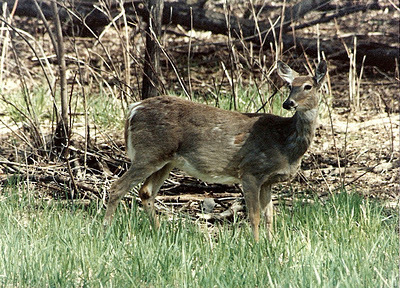 Photo by Wayne T. Allison
Photo by Wayne T. AllisonThe October 15 issue of This Land may be the best yet. I'm honored to be included with this eclectic crew. Here's the run-down from This Land's website:
http://thislandpress.com/issues/october-15th-2011/
This issue is downright bacchanalian, and we make no apologies for basking in lush, hedonistic glory. Coming up:TOGETHER IN TULSA: Anna Kathleen Casey on Hannah and Chris Middlebrook, and the party animal that is "Clonky the Clown."GOODBYE TULSA: Shawna Lewis on Elizabeth Ashwood Davis, a 34-year-old writer who died in her sleep.IMAGINARY OK: Author Steve Almond imagines himself as a rock legend looking back on his past.URBAN CHICKEN: Rebekah Greiman finds a few Tulsans fed up enough with food-source mystery to raise their own laying hens.POETRY: The Stringtown Prison Poetry Workshop presents a collaborative poem, "Stringtown Prison Blues."VINTAGE SMITH: Mark Brown goes to Walla Walla, Washington, to find out why the hottest winemaker in America wears his love of Bob Wills and Woody Guthrie on his sleeve.DEVIL'S ADVOCATE: Sarah Fonder talks to poet activist Mary McAnally about editing a book of prison poetry.TENT MAKERS AND PROPHETS: An excerpt on Oklahoma's role in the rise of evangelical conservatism, by Darren Dochuk.SPORTS ILLUSTRATION: Jeremy Luther pays tribute to a defeated, but not dishonored, college football team.THE DARKNESS CANNOT OVERCOME THE LIGHT: Josh Kline explains why an Edmond-based website on capnolagnia – a sexual fetish based on the sight or image of a person smoking – is among the Internet's oldest.A KILLING: Gordon Grice dissects a couple's profound love through the incident of a gut-shot deer.LET THEM BEAT CAKE: Natasha Ball examines the not-quite-cakes of Kerry Vincent's annual cookoff, the Oklahoma Sugar Art Show.TRUE TULSA DOUBLE FEATURE: Grant McClintock shares two photographs of local artist Dan Mayo–one from 2011, and one from 1987.That, plus the usual from design savante Carlos Knight and illustration wunderkind Jeremy Luther.
Published on October 24, 2011 09:00
October 23, 2011
Australia: Great White Shark Kills American
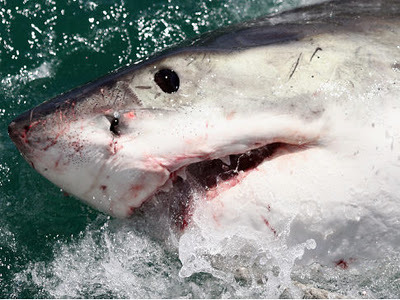
Great white shark kills American man off the coast of western Australia:
"The first hint the recreational diver—whose name and hometown have not been made public yet –was in trouble occurred when a stream of bubbles were spotted at the surface nearby his dive boat.
His two terrified companions on the vessel said his lifeless body was seen shortly afterward, and a 10-foot shark was seen swimming away."
Published on October 23, 2011 10:20
October 22, 2011
Advice to Ohioans: How to Avoid Animal Attacks

On the heels of the massive animal escape in Ohio, Men's Journal turned to your favorite nature writer for comfort and advice.
Advice to Ohioans: How to Avoid Animal Attacks | Men's Journal:
"By the time you see a cougar, you're probably already in trouble, says Grice. "
Photo by Hodari Nundu
Published on October 22, 2011 09:00
October 21, 2011
Grice in The Times

Wednesday's edition of The Times (London) carried my article on hoofed animals and the people they trample.
Published on October 21, 2011 08:00

